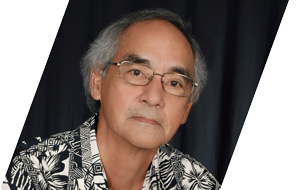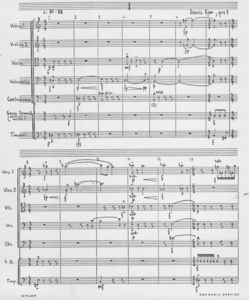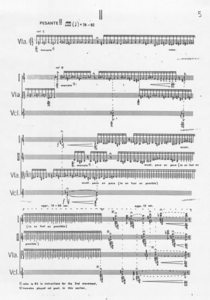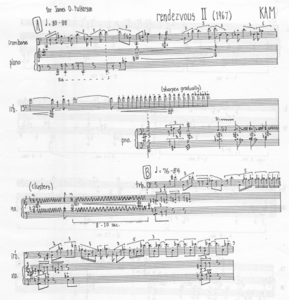
Early Years
A Guide to Dennis Kam's Music.
By John Van der Slice.
Dennis's early composition was “modernist,” reflecting many major composers of the 20th century. He initially incorporated two important hallmarks: rhythmic unpredictability and the avoidance of consonance. Syncopated percussive accents and tonal distortions can be heard in the Suite for Piano (1960) and the Paul Hindemith-influenced Sonata for Trombone (1961-62). The prolonged tension of Arnold Schoenberg's atonality is felt in the Wind Quintet (1962) and the Five Pieces for String Orchestra and Percussion (1963).
Listen to "5 Pieces for String Orchestra and Percussion" (1967)
keyboard_arrow_downAnton Webern's haiku-like brevity informs the Five Phases for Solo Flute (1965) as well as Ensembles II (1965). Edgard Varèse and the Polish School (Krysztof Penderecki and Witold Lutosławski) impact later works with dense textures, forceful sustained dissonance and string glissandi. Rendezvous I for two pianos (1966) echoes the sound mass of works like Penderecki's Threnody (1959-61).
Both the Quartet for Strings No. 1 (1966) and Rendezvous II (1967) for trombone and piano represent a sport-like excitement of rhythmic uncertainty as well as what will remain signature characteristics of much of his music: punctuation and a motoric persistence.
Listen to the mentioned compositions
keyboard_arrow_downThe Quartet makes use of a spasmodic pointillism, energetically pushing ahead with sustained tremolos. These last are disrupted by isolated accents and the work eventually resolves into pulsing rhythmic regularity. In Rendezvous II the trombone and piano engage in a brutal sparring match in which staggered marcato accents vie with shared points of coincidence. The short bursts of repeated pitches found in both works will remain a signature trait.
Two musical spoofs betray a growing dissatisfaction with European modernism by mocking its style. A third exploits non sequitur.
In the first, the Dadaist Recitative for Pianist (1971), the performer begins with an obsessively manic, widely spaced, and rhythmically irregular pointillism which lasts unvaried for more than two minutes before being interrupted suddenly by a strident sustained vocal pitch. The activity resumes and continues for another minute until interrupted once again... and so on ad absurdum until it ends with a cadential formula that is repeated ad nauseam (in the manner of Erik Satie's Embryons desséchés III ). This last may signal a tipping point for the composer's modernist ambivalence toward repetition itself, a procedure that he will later embrace enthusiastically.
Listen to "Recitative for Pianist" (1971)
keyboard_arrow_downIn the second, Go (1971) for clarinet, cello (or contrabass) and trombone, harsh (i.e., modernistic) elements become increasingly separated by silences while the conductor executes bafflingly complex metric patterns that continue to the end, long after the instruments have stopped playing.
The third, Blue Paradise (1971), uses occasional quotation within a rapid succession of illogical contrasts in the manner of television channel hopping. This technique can also be found in the music of Satie and George Antheil but more significantly in Michael Tippett's Piano Sonata No. 2, a work that proved especially influential later on.
Re-actions (1972) for piano, three trombones and timpani is an essay in sheer brute energy and pits instrumental types against each other with unsparing aggressiveness. Undoubtedly inspired by a favorite work at the time, Iannis Xenakis' Eonta, it is an apotheosis of modernist cathartic intensity to which the composer would never return.
Listen to "Re-actions" (1972)
keyboard_arrow_down



